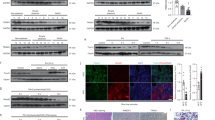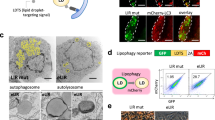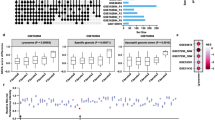Abstract
Non-alcoholic steatohepatitis (NASH) is an increasingly prevalent liver pathology that can progress from non-alcoholic fatty liver disease (NAFLD), and it is a leading cause of cirrhosis and hepatocellular carcinoma. There is currently no pharmacological therapy for NASH. Defective lysosome-mediated protein degradation is a key process that underlies steatohepatitis and a well-recognized drug target in a variety of diseases; however, whether it can serve as a therapeutic target for NAFLD and NASH remains unknown. Here we report that transmembrane BAX inhibitor motif-containing 1 (TMBIM1) is an effective suppressor of steatohepatitis and a previously unknown regulator of the multivesicular body (MVB)-lysosomal pathway. Tmbim1 expression in hepatocytes substantially inhibited high-fat diet–induced insulin resistance, hepatic steatosis and inflammation in mice. Mechanistically, Tmbim1 promoted the lysosomal degradation of toll-like receptor 4 by cooperating with the ESCRT endosomal sorting complex to facilitate MVB formation, and the ubiquitination of Tmbim1 by the E3 ubiquitin ligase Nedd4l was required for this process. We also found that overexpression of Tmbim1 in the liver effectively inhibited a severe form of NAFLD in mice and NASH progression in monkeys. Taken together, these findings could lead to the development of promising strategies to treat NASH by targeting MVB regulators to properly orchestrate the lysosome-mediated protein degradation of key mediators of the disease.
This is a preview of subscription content, access via your institution
Access options
Access Nature and 54 other Nature Portfolio journals
Get Nature+, our best-value online-access subscription
$29.99 / 30 days
cancel any time
Subscribe to this journal
Receive 12 print issues and online access
$209.00 per year
only $17.42 per issue
Buy this article
- Purchase on Springer Link
- Instant access to full article PDF
Prices may be subject to local taxes which are calculated during checkout






Similar content being viewed by others
Accession codes
References
Wree, A., Broderick, L., Canbay, A., Hoffman, H.M. & Feldstein, A.E. From NAFLD to NASH to cirrhosis—new insights into disease mechanisms. Nat. Rev. Gastroenterol. Hepatol. 10, 627–636 (2013).
Younossi, Z.M. et al. Global epidemiology of non-alcoholic fatty liver disease—meta-analytic assessment of prevalence, incidence and outcomes. Hepatology 64, 73–84 (2016).
Cohen, J.C., Horton, J.D. & Hobbs, H.H. Human fatty liver disease: old questions and new insights. Science 332, 1519–1523 (2011).
Byrne, C.D. & Targher, G. NAFLD: a multisystem disease. J. Hepatol. 62 (Suppl. 1), S47–S64 (2015).
LaBrecque, D.R. et al. World Gastroenterology Organization global guidelines: non-alcoholic fatty liver disease and non-alcoholic steatohepatitis. J. Clin. Gastroenterol. 48, 467–473 (2014).
Haas, J.T., Francque, S. & Staels, B. Pathophysiology and mechanisms of non-alcoholic fatty liver disease. Annu. Rev. Physiol. 78, 181–205 (2016).
Zhang, H.J. et al. Effects of moderate and vigorous exercise on non-alcoholic fatty liver disease: a randomized clinical trial. JAMA Intern. Med. 176, 1074–1082 (2016).
Noureddin, M., Zhang, A. & Loomba, R. Promising therapies for treatment of non-alcoholic steatohepatitis. Expert Opin. Emerg. Drugs 21, 343–357 (2016).
Ye, D. et al. Toll-like receptor 4 mediates obesity-induced non-alcoholic steatohepatitis through activation of X-box binding protein 1 in mice. Gut 61, 1058–1067 (2012).
Husebye, H. et al. Endocytic pathways regulate Toll-like receptor 4 signaling and link innate and adaptive immunity. EMBO J. 25, 683–692 (2006).
Scita, G. & Di Fiore, P.P. The endocytic matrix. Nature 463, 464–473 (2010).
Hanson, P.I. & Cashikar, A. Multivesicular body morphogenesis. Annu. Rev. Cell Dev. Biol. 28, 337–362 (2012).
Ciechanover, A. Intracellular protein degradation: from a vague idea thru the lysosome and the ubiquitin–proteasome system and onto human diseases and drug targeting. Cell Death Differ. 12, 1178–1190 (2005).
Xu, H. & Ren, D. Lysosomal physiology. Annu. Rev. Physiol. 77, 57–80 (2015).
Zhao, H. et al. RECS1 deficiency in mice induces susceptibility to cystic medial degeneration. Genes Genet. Syst. 81, 41–50 (2006).
Shukla, S. et al. A shear-stress-responsive gene product PP1201 protects against Fas-mediated apoptosis by reducing Fas expression on the cell surface. Apoptosis 16, 162–173 (2011).
Lisak, D.A. et al. The transmembrane Bax inhibitor motif (TMBIM)-containing protein family: tissue expression, intracellular localization and effects on the ER Ca2+-filling state. Biochim. Biophys. Acta 1853, 2104–2114 (2015).
Zhao, H. et al. RECS1 is a negative regulator of matrix metalloproteinase 9 production and aged RECS1-knockout mice are prone to aortic dilation. Circ. J. 70, 615–624 (2006).
Malhi, H., Guicciardi, M.E. & Gores, G.J. Hepatocyte death: a clear and present danger. Physiol. Rev. 90, 1165–1194 (2010).
Song, C.Y. et al. Sophocarpine attenuates Toll-like receptor 4 in steatotic hepatocytes to suppress pro-inflammatory cytokines synthesis. J. Gastroenterol. Hepatol. 30, 405–412 (2015).
Wang, Y. et al. Lysosome-associated small Rab GTPase Rab7b negatively regulates TLR4 signaling in macrophages by promoting lysosomal degradation of TLR4. Blood 110, 962–971 (2007).
Palsson-McDermott, E.M. et al. TAG, a splice variant of the adaptor TRAM, negatively regulates the adaptor MyD88-independent TLR4 pathway. Nat. Immunol. 10, 579–586 (2009).
Vespasiani-Gentilucci, U. et al. Hepatic Toll-like receptor 4 expression is associated with portal inflammation and fibrosis in patients with NAFLD. Liver Int. 35, 569–581 (2015).
Zhang, R.N. et al. Saturated fatty acid inhibits viral replication in chronic hepatitis B virus infection with non-alcoholic fatty liver disease by Toll-like receptor 4–mediated innate immune response. Hepat. Mon. 15, e27909 (2015).
Henao-Mejia, J. et al. Inflammasome-mediated dysbiosis regulates progression of NAFLD and obesity. Nature 482, 179–185 (2012).
Seki, E. et al. TLR4 enhances TGF-β signaling and hepatic fibrosis. Nat. Med. 13, 1324–1332 (2007).
Jacobs, F. & Wang, L. Adeno-associated viral vectors for correction of inborn errors of metabolism: progressing towards clinical application. Curr. Pharm. Des. 17, 2500–2515 (2011).
Cisco, R.M. et al. Induction of human dendritic cell maturation using transfection with RNA encoding a dominant-positive Toll-like receptor 4. J. Immunol. 172, 7162–7168 (2004).
Liaunardy-Jopeace, A. & Gay, N.J. Molecular and cellular regulation of Toll-like receptor 4 activity induced by lipopolysaccharide ligands. Front. Immunol. 5, 473 (2014).
Henne, W.M., Buchkovich, N.J. & Emr, S.D. The ESCRT pathway. Dev. Cell 21, 77–91 (2011).
Raiborg, C. & Stenmark, H. The ESCRT machinery in endosomal sorting of ubiquitylated membrane proteins. Nature 458, 445–452 (2009).
Ren, X. & Hurley, J.H. Proline-rich regions and motifs in trafficking: from ESCRT interaction to viral exploitation. Traffic 12, 1282–1290 (2011).
Lu, Q., Hope, L.W., Brasch, M., Reinhard, C. & Cohen, S.N. TSG101 interaction with HRS mediates endosomal trafficking and receptor downregulation. Proc. Natl. Acad. Sci. USA 100, 7626–7631 (2003).
Bache, K.G., Brech, A., Mehlum, A. & Stenmark, H. Hrs regulates multivesicular body formation via ESCRT recruitment to endosomes. J. Cell Biol. 162, 435–442 (2003).
Davies, B.A., Lee, J.R., Oestreich, A.J. & Katzmann, D.J. Membrane protein targeting to the MVB–lysosome. Chem. Rev. 109, 1575–1586 (2009).
Shields, S.B. & Piper, R.C. How ubiquitin functions with ESCRTs. Traffic 12, 1306–1317 (2011).
Hurley, J.H. & Stenmark, H. Molecular mechanisms of ubiquitin-dependent membrane traffic. Annu. Rev. Biophys. 40, 119–142 (2011).
Rotin, D. & Kumar, S. Physiological functions of the HECT family of ubiquitin ligases. Nat. Rev. Mol. Cell Biol. 10, 398–409 (2009).
Martin-Serrano, J., Eastman, S.W., Chung, W. & Bieniasz, P.D. HECT ubiquitin ligases link viral and cellular PPXY motifs to the vacuolar protein sorting pathway. J. Cell Biol. 168, 89–101 (2005).
Townsend, S.A. & Newsome, P.N. Non-alcoholic fatty liver disease in 2016. Br. Med. Bull. 119, 143–156 (2016).
Velloso, L.A., Folli, F. & Saad, M.J. TLR4 at the crossroads of nutrients, gut microbiota and metabolic inflammation. Endocr. Rev. 36, 245–271 (2015).
Abu-Shanab, A. & Quigley, E.M. The role of the gut microbiota in non-alcoholic fatty liver disease. Nat. Rev. Gastroenterol. Hepatol. 7, 691–701 (2010).
Pal, D. et al. Fetuin-A acts as an endogenous ligand of TLR4 to promote lipid-induced insulin resistance. Nat. Med. 18, 1279–1285 (2012).
Holland, W.L. et al. Lipid-induced insulin resistance mediated by the pro-inflammatory receptor TLR4 requires saturated fatty acid–induced ceramide biosynthesis in mice. J. Clin. Invest. 121, 1858–1870 (2011).
Wong, S.W. et al. Fatty acids modulate Toll-like receptor 4 activation through regulation of receptor dimerization and recruitment into lipid rafts in a reactive oxygen species–dependent manner. J. Biol. Chem. 284, 27384–27392 (2009).
Spruss, A. et al. Toll-like receptor 4 is involved in the development of fructose-induced hepatic steatosis in mice. Hepatology 50, 1094–1104 (2009).
Jia, L. et al. Hepatocyte Toll-like receptor 4 regulates obesity-induced inflammation and insulin resistance. Nat. Commun. 5, 3878 (2014).
Sharifnia, T. et al. Hepatic TLR4 signaling in obese NAFLD. Am. J. Physiol. Gastrointest. Liver Physiol. 309, G270–G278 (2015).
Hirosumi, J. et al. A central role for JNK in obesity and insulin resistance. Nature 420, 333–336 (2002).
Ashkenazi, A. & Salvesen, G. Regulated cell death: signaling and mechanisms. Annu. Rev. Cell Dev. Biol. 30, 337–356 (2014).
Okin, D. & Medzhitov, R. The effect of sustained inflammation on hepatic mevalonate pathway results in hyperglycemia. Cell 165, 343–356 (2016).
Chalasani, N. et al. The diagnosis and management of non-alcoholic fatty liver disease: practice guideline by the American Gastroenterological Association, American Association for the Study of Liver Diseases and American College of Gastroenterology. Gastroenterology 142, 1592–1609 (2012).
Zhang, N. et al. Pharmacological TLR4 inhibition protects against acute and chronic fat-induced insulin resistance in rats. PLoS One 10, e0132575 (2015).
Poltorak, A. et al. Defective LPS signaling in C3H/HeJ and C57BL/10ScCr mice: mutations in Tlr4 gene. Science 282, 2085–2088 (1998).
Musso, G., Cassader, M. & Gambino, R. Non-alcoholic steatohepatitis: emerging molecular targets and therapeutic strategies. Nat. Rev. Drug Discov. 15, 249–274 (2016).
Baiceanu, A., Mesdom, P., Lagouge, M. & Foufelle, F. Endoplasmic reticulum proteostasis in hepatic steatosis. Nat. Rev. Endocrinol. 12, 710–722 (2016).
Czech, M.P. Obesity Notches up fatty liver. Nat. Med. 19, 969–971 (2013).
Wang, P.X. et al. Targeting CASP8 and FADD-like apoptosis regulator ameliorates non-alcoholic steatohepatitis in mice and nonhuman primates. Nat. Med. 23, 439–449 (2017).
Ratner, M. Gilead bets big on Nimbus' fatty liver disease drug. Nat. Biotechnol. 34, 575–576 (2016).
Davis, R.J. Signal transduction by the JNK group of MAP kinases. Cell 103, 239–252 (2000).
National Research Council. Guide for the Care and Use of Laboratory Animals 8th edn. (The National Academies Press, 2011).
Wang, P.X. et al. Hepatocyte TRAF3 promotes liver steatosis and systemic insulin resistance through targeting TAK1-dependent signaling. Nat. Commun. 7, 10592 (2016).
Gao, L. et al. Tumor necrosis factor receptor–associated factor 5 (Traf5) acts as an essential negative regulator of hepatic steatosis. J. Hepatol. 65, 125–136 (2016).
Xiang, M. et al. Targeting hepatic TRAF1–ASK1 signaling to improve inflammation, insulin resistance and hepatic steatosis. J. Hepatol. 64, 1365–1377 (2016).
Kleiner, D.E. et al. Design and validation of a histological scoring system for non-alcoholic fatty liver disease. Hepatology 41, 1313–1321 (2005).
Osawa, Y. et al. Roles for C16-ceramide and sphingosine 1-phosphate in regulating hepatocyte apoptosis in response to tumor necrosis factor–α. J. Biol. Chem. 280, 27879–27887 (2005).
Yan, F.J. et al. The E3 ligase TRIM8 targets TAK1 to promote insulin resistance and steatohepatitis. Hepatology http://dx.doi.org/10.1002/hep.28971 (2016).
Moffat, J. et al. A lentiviral RNAi library for human and mouse genes applied to an arrayed viral high-content screen. Cell 124, 1283–1298 (2006).
Kim, J.H. et al. High cleavage efficiency of a 2A peptide derived from porcine teschovirus-1 in human cell lines, zebrafish and mice. PLoS One 6, e18556 (2011).
Xie, L. et al. DKK3 expression in hepatocytes defines susceptibility to liver steatosis and obesity. J. Hepatol. 65, 113–124 (2016).
Zlatic, S.A., Ryder, P.V., Salazar, G. & Faundez, V. Isolation of labile multiprotein complexes by in vivo–controlled cellular cross-linking and immuno-magnetic affinity chromatography. J. Vis. Exp. 37, e1855 (2010).
Wang, X. et al. NEDD4-1 is a proto-oncogenic ubiquitin ligase for PTEN. Cell 128, 129–139 (2007).
Zhang, X. et al. Rhesus macaques develop metabolic syndrome with reversible vascular dysfunction responsive to pioglitazone. Circulation 124, 77–86 (2011).
Wang, L. et al. AAV8-mediated hepatic gene transfer in infant rhesus monkeys (Macaca mulatta). Mol. Ther. 19, 2012–2020 (2011).
Kraus, D. et al. Nicotinamide N-methyltransferase knockdown protects against diet-induced obesity. Nature 508, 258–262 (2014).
Oh, D.Y. et al. A Gpr120-selective agonist improves insulin resistance and chronic inflammation in obese mice. Nat. Med. 20, 942–947 (2014).
Wang, X.A. et al. Interferon regulatory factor 9 protects against hepatic insulin resistance and steatosis in male mice. Hepatology 58, 603–616 (2013).
Wang, X.A. et al. Interferon regulatory factor 3 constrains IKKβ–NF-κB signaling to alleviate hepatic steatosis and insulin resistance. Hepatology 59, 870–885 (2014).
Acknowledgements
We appreciate L. Wan and J. Li (Huazhong University of Science and Technology) for PET operation. We thank L. Ma (Wuhan University), a biostatistics expert, for his help with our statistical analyses. This work was supported by the National Science Fund for Distinguished Young Scholars (grant no. 81425005; H.L.), the National Natural Science Foundation (grant no. 81330005 (H.L.), 81630011 (H.L.) and 91329000 (H.L.)), National Science and Technology Support Project no. 2014BAI02B01 (H.L.) and 2015BAI08B01 (H.L.), and National Key Research and Development Program no. 2013YQ030923-05 (H.L.) and 2016YFF0101504 (Z.-G.S.).
Author information
Authors and Affiliations
Contributions
G.-N.Z., P.Z., J.G. and X.-J.Z. designed and performed experiments, analyzed data and wrote the manuscript; P.-X.W., M.Y., Z.J., Y.-X.J., J.T. and Yutao Wang performed experiments, analyzed data and provided useful advice on the manuscript; J.F. and Yong Wang performed the monkey experiments; X.-Y.Z. performed the western blot experiments; X.Z. constructed the genetically engineered mice used here; L.-J.S. and Q.-F.W. established the mouse models of severe NAFLD and performed mouse experiments; Q.X. performed the PET experiments; Z.-G.S., Z.W. and Z.H. helped design the project and edited the manuscript; and H.L. designed and supervised the experiments and wrote the manuscript.
Corresponding author
Ethics declarations
Competing interests
The authors declare no competing financial interests.
Supplementary information
Supplementary Figures and Tables
Supplementary Figures 1–25 and Supplementary Tables 1–4 (PDF 7027 kb)
Supplementary Table 5
Identified proteins interacting with TMBIM1 by mass spectrometry (XLSX 12 kb)
Rights and permissions
About this article
Cite this article
Zhao, GN., Zhang, P., Gong, J. et al. Tmbim1 is a multivesicular body regulator that protects against non-alcoholic fatty liver disease in mice and monkeys by targeting the lysosomal degradation of Tlr4. Nat Med 23, 742–752 (2017). https://doi.org/10.1038/nm.4334
Received:
Accepted:
Published:
Issue Date:
DOI: https://doi.org/10.1038/nm.4334
This article is cited by
-
MicroRNA-582-3p knockdown alleviates non-alcoholic steatohepatitis by altering the gut microbiota composition and moderating TMBIM1
Irish Journal of Medical Science (1971 -) (2024)
-
Lysosomal-associated protein transmembrane 5 ameliorates non-alcoholic steatohepatitis by promoting the degradation of CDC42 in mice
Nature Communications (2023)
-
Recent updates on targeting the molecular mediators of NAFLD
Journal of Molecular Medicine (2023)
-
Mitochondrial genome copy number measured by DNA sequencing in human blood is strongly associated with metabolic traits via cell-type composition differences
Human Genomics (2021)
-
The metabolic regulator Lamtor5 suppresses inflammatory signaling via regulating mTOR-mediated TLR4 degradation
Cellular & Molecular Immunology (2020)



